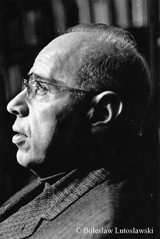Stanislaw Lem 1921-2006
 Lem is both a polymath and a virtuoso storyteller and stylist. Put them together and they add up to a genius... He has been steadily producing fiction that follows the arcs and depths of his learning and a bewildering labyrinth of moods and attitudes. Like his protagonists, loners virtually to a man, his fiction seems at a distance from the daily cares and passions, and conveys the sense of a mind hovering above the boundaries of the human condition: now mordant, now droll, now arcane, now folksy, now skeptical, now haunted and always paradoxical. Yet his imagination is so powerful and pure that no matter what world he creates it is immediately convincing because of its concreteness and plentitude, the intimacy and authority with which it is occupied... read Lem for yourself. He is a major writer, and one of the deep spirits of our age.
Lem is both a polymath and a virtuoso storyteller and stylist. Put them together and they add up to a genius... He has been steadily producing fiction that follows the arcs and depths of his learning and a bewildering labyrinth of moods and attitudes. Like his protagonists, loners virtually to a man, his fiction seems at a distance from the daily cares and passions, and conveys the sense of a mind hovering above the boundaries of the human condition: now mordant, now droll, now arcane, now folksy, now skeptical, now haunted and always paradoxical. Yet his imagination is so powerful and pure that no matter what world he creates it is immediately convincing because of its concreteness and plentitude, the intimacy and authority with which it is occupied... read Lem for yourself. He is a major writer, and one of the deep spirits of our age.
Theodore Solotaroff "The New York Times Book Review"
The Beautiful Mind-Bending of Stanislaw Lem

 Yet his writing reached far beyond the borders of the genre. In addition to many novels and stories, he composed a huge philosophical treatise on the relation of human beings and machines, a good deal of pungently argued literary criticism, a volume of reviews of nonexistent books, a stochastic theory of narrative fiction, an experimental detective novel, speculative essays dealing with artificial intelligence, cybernetics, cosmology, genetic engineering, game theory, sociology, and evolution, radio plays and screenplays. Such staggering polymathic curiosity over such a vast range of material, all of it explored with lucidity and charm, gives his writing a unique place on a Venn diagram in which the natural sciences, philosophy, and literature shade into one another with mutually intensifying vividness and fascination.
Yet his writing reached far beyond the borders of the genre. In addition to many novels and stories, he composed a huge philosophical treatise on the relation of human beings and machines, a good deal of pungently argued literary criticism, a volume of reviews of nonexistent books, a stochastic theory of narrative fiction, an experimental detective novel, speculative essays dealing with artificial intelligence, cybernetics, cosmology, genetic engineering, game theory, sociology, and evolution, radio plays and screenplays. Such staggering polymathic curiosity over such a vast range of material, all of it explored with lucidity and charm, gives his writing a unique place on a Venn diagram in which the natural sciences, philosophy, and literature shade into one another with mutually intensifying vividness and fascination.
Paul Grimstad, The New Yorker, January 6, 2019
A brilliant trip back to the technological future
It is amazing how much Lem got right, or even predicted. This ranges across artificial intelligence, the theory of search engines (he called it “ariadnology”), bionics, virtual reality (“phantomatics”), technological singularity and nanotechnology.
Simon Ings "New Scientist"




